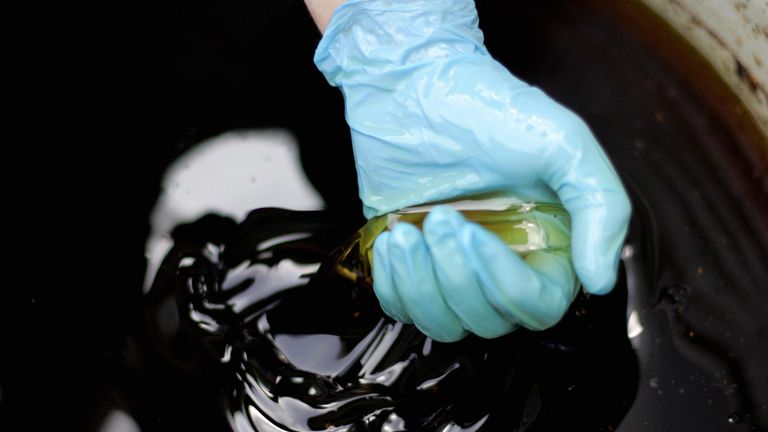Bidding war for Anadarko heats up as Oxy secures new talks
Sky's Ian King says a takeover may be a 'one and done' deal for the shale sector following a rush for prime Texas sites.
Monday 29 April 2019 18:48, UK
The shale industry has already shaken global energy markets by making the United States, not Saudi Arabia, the world's biggest 'swing' producer.
That means it is the country most capable of adding to, or reducing, supply in a way that influences the price of oil.
Yet what is interesting about the shale industry is that, until relatively recently, it has largely been the preserve of smaller independent players rather than the world's biggest oil and gas producers.
That perception began to change when, in July last year, BP announced that it was paying $10.5bn (£8.1bn) for mining giant BHP's US shale assets in its biggest acquisition in nearly two decades.
Now a bidding war has broken out for Anadarko Petroleum, whose most-prized assets are its acreage in the Permian Basin in Texas, the heart of the US shale industry.
The action got under way when, on 12 April, Anadarko announced it had agreed to be taken over by Chevron, America's second largest oil company, in a deal that, when Anadarko's debt was included, was worth $50bn.
Then last week, Occidental - one of America's top five oil companies, but substantially smaller than Chevron - popped up to say it was interested in Anadarko.
It was prepared to pay $55bn, including Anadarko's debt.
Anadarko confirmed on Monday it was entering takeover talks with the company, known informally on Wall Street as 'Oxy'.
The big question is whether Chevron now comes back with a higher offer.
Buying Anadarko would have made it the world's fourth so-called 'ultra-major' listed oil company after ExxonMobil, Royal Dutch Shell and BP.
Crucially, Anadarko would also have cemented Chevron's position as the most important player in the Permian Basin, which is now seen as the world's most exciting exploration prospect.
Much of Anadarko's acreage in the field borders acreage owned by Chevron. There would, accordingly, have been a lot of savings to have been made by combining the two companies.
This was a crucial attraction in a region where, despite the fact that the oil is relatively cheap to get out of the ground, costs have been rising due to labour shortages and a limited supply of pipeline capacity to transport the crude elsewhere.
A takeover by Chevron would also confirm the region's growing interest to the global oil industry's biggest players.
ExxonMobil, BP and Shell largely missed the initial excitement of the shale revolution as smaller independents, like Anadarko, got in first to experiment with, what was then, seen as new and untested technology.
Yet attitudes have changed over time and, with Anadarko having a higher level of debt than most players in the industry, its ability to exploit its shale assets was seen as constrained.
Those factors are also why Occidental wants Anadarko. It too is already a major player in the Permian Basin and it too wants the opportunity to make major savings and enjoy what are known as 'synergy benefits' following a takeover.
Buying Anadarko would make it the clear number three player among US oil and gas companies after ExxonMobil and Chevron.
Yet the deal would also put Occidental's balance sheet under pressure once it assumed Anadarko's debt.
That is why its chief executive, Vicki Hollub, has put together a deal in which Anadarko's investors would receive 50% in cash and 50% in Occidental shares whereas Chevron is offering a mix of 75% in cash and just 25% in shares.
Ms Hollub has also committed to sell between $10bn-$15bn worth of assets after the deal in order to reduce any strain on its balance sheet.
Either way, the bidding war is a godsend for investors in Anadarko, whose shares were trading at just $46.80 before Chevron first broke cover with its $65-a-share offer.
Occidental is offering $76-a-share; the shares were changing hands last July, prior to the fall in crude prices in the second half of last year, at that price.
Another big question is whether, regardless of who ultimately wins the battle for Anadarko, the bidding battle will trigger a wave of mergers and acquisitions across the industry.
Some analysts think it will on the grounds that the US oil and gas sector has too many publicly-quoted companies, particularly in the mid-sized space, making it ripe for consolidation.
The likes of Apache Corporation - another major operator in the Permian Basin and which also has significant interests in the North Sea - Noble Energy, Pioneer Natural Resources and Parsley Energy are all seen as potential targets and especially because, in most cases, the shares of these companies trade at discount to their net asset value (the price, per share, that investors would receive if the company were wound up today and its assets divided up among them).
But others suspect that the big integrated oil companies, in particular, will not rush into buying up smaller rivals.
The fragmentation of operations in the Permian Basin, where there are 430 rigs being operated by 110 different operators, mean that there is no need to rush.
Operating rigs is a capital-intensive business and many of these small operators - around half of the players in the Permian Basin operate just three rigs or fewer - may eventually go bust if the oil price sells off again.
The independent shale drillers, collectively, lost money during the final three months of last year. So the big boys may prefer to wait it out and particularly given the more disciplined approach that they have taken to capital since watching the oil price crash in the second half of 2014 render uneconomic many of the investment projects that they had under way at that time.
At the moment, the market is betting that there will not be further deals. After an initial flurry of excitement, when Chevron's interest first became public, shares of the likes of Apache and Pioneer have since settled down again.
But interest in the Permian is not going to go away.







